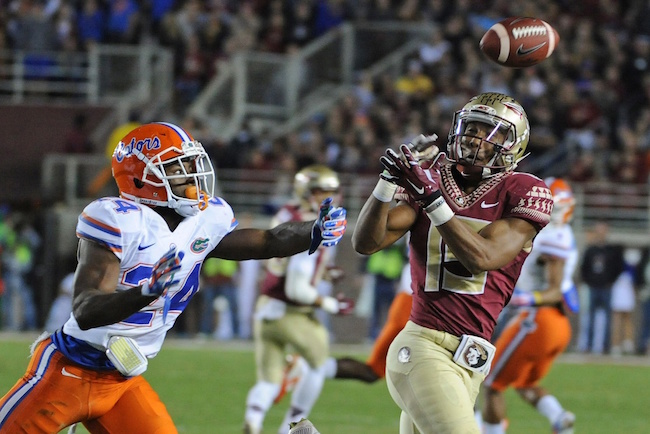
Position-by-position edge: Florida State at Florida
Taking a position-by-position look at Florida State vs. Florida, here’s what to watch for in Saturday’s showdown between the Seminoles and Gators:
QUARTERBACK – Florida State: FSU started the season with graduate transfer Everett Golson as its signal-caller, but redshirt junior Sean Maguire (76-of-117, 968 yards, 8 TD, 2 INT) will be the starter on Saturday. Maguire will be making his first start in The Swamp, but he’s familiar with hostile environments because he got the start at Clemson in Week 10 (16-for-29, 164 yards, INT).
Treon Harris will lead Florida’s offense in his sixth start since Will Grier’s season-ending suspension. Harris guided the Gators to a 27-3 victory over Georgia in Week 9, but has put up subpar numbers over the past three games (39-for-74, 536 yards, 3 TD, 4 INT) against below .500 competition. Most alarming for Harris has been the recent turnover trouble, because previously the Gators could depend on his game-management skills.
RUNNING BACKS – Florida State: Former UF commit Dalvin Cook could be the factor that tips the game in the Seminoles’ favor. FSU’s potential Heisman candidate has made opposing defenses pay for even the slightest mistakes, with one missed tackle potentially turning into six points. Cook (185 carries, 1,475 yards, 16 TD) will try to extend his streak of 100-yard games to four against a banged-up UF defense. It would be unrealistic for the Gators to expect to completely shut him down, but containing him is a must to keep this game close.
If Florida can get Kelvin Taylor (217 carries, 841 yards, 13 TD) going on the ground, the Gators might try a keep-away strategy against FSU. One encouraging sign for Florida is Taylor’s first set of back-to-back 100-yard games this season came in the past two weeks.
WIDE RECEIVERS, TIGHT END – Florida State: The combined stat line for FSU’s top three receivers (Travis Rudolph, Kermit Whitfield and Jesus Wilson) comes in at 147 yards, 1,899 yards and 14 touchdowns. Those numbers are a little better than the sum of 143 catches, 1,703 yards and 13 touchdowns from UF’s top four pass catchers (Antonio Callaway, Demarcus Robinson, Jake McGee and Brandon Powell).
OFFENSIVE LINE – Florida State: The Seminoles aren’t in a position to brag about being No. 57 in sacks allowed (21), but that’s a lot better than Florida’s No. 114 ranking (33 sacks allowed). Both teams have running backs with breakaway speed, but FSU does a much better job opening up holes for Cook. Florida has made it to 10-1 with an inexperienced, thin offensive line, but recent injuries to LT David Sharpe and LG Martez Ivey have revealed even the slightest personnel changes lead to significant breakdowns in blocking. Florida State’s offensive line has also been dealt repeated injury blows, including to RT Derrick Kelly.
DEFENSIVE LINE – Push: If Florida coach Jim McElwain’s Monday injury report is accurate, one of the Gators’ biggest team strengths could be severely weakened. DL Jonathan Bullard (53 total tackles, 13.5 tackles for loss, 5.5 sacks) has been the primary disruptor on the line, often opening up the way for other linemen like Alex McCalister (26 tackles, 9.5 TFL, 6.5 sacks), CeCe Jefferson (25 tackles, 7 TFL, 2.5 sacks) and Bryan Cox (36 tackles, 9.5 TFL, 2.5 sacks) to get to the quarterback. If Joey Ivie (questionable) and Caleb Brantley (probable) join Cox and Jefferson on the line, UF will have a formidable presence up front, though not nearly as potent as with McCalister (out) and Bullard (doubtful).
FSU’s matchup with Florida’s offensive line could have the Seminoles’ defensive line finishing with the better box score. Florida State has rotated a few linemen this season, with DeMarcus Walker the most notable standout. Walker’s eight sacks make him No. 3 in the ACC. DE Josh Sweat (32 tackles, 3.5 TFL, sack) has previously demonstrated what he can do against Ivey.
LINEBACKERS – Florida: Both teams entered this season lacking experienced depth at linebacker. Florida leans on two aggressive, athletic linebackers in Antonio Morrison (84 tackles, 11 TFL, 2.5 sacks) and Jarrad Davis (77 tackles, 10 TFL, 2.5 sacks), who deserve a lot of credit for the team’s rush defense being ranked No. 8 in the FBS.
FSU’s front seven isn’t quite as effective stopping the ground game, with the rushing defense coming in at No. 39. Reggie Northrup leads the Seminoles in tackles with 78, while fellow senior Terrance Smith (44 tackles, 3.5 TFL) has provided FSU a boost after missing a few games in October.
SECONDARY – Florida: Arguably the most talented unit for both teams, Florida has the slightly better overall unit, but FSU might have more playmaking opportunities if the Gators put the ball in the air.
In social media trash-talk, Gators and Seminoles fans like to argue over who is the better cornerback, UF’s Vernon Hargreaves III (4 INT, 2 pass breakups) or FSU’s Jalen Ramsey (39 total tackles, 10 PBU). Hargreaves is best known for lockdown coverage (and taking receivers out of the game) while Ramsey delivers huge hits. Both look to have bright futures playing on Sundays.
Ramsey, though, isn’t the only impact player in FSU’s secondary. S Derwin James (68 total tackles, 4 PBU) is a hard-hitter and noted freak of nature.
One wouldn’t expect the Seminoles to go with a pass-heavy approach in The Swamp. UF CB Jalen Tabor (4 INT, 14 PBU) is having an excellent season, but finds himself in Hargreaves’ shadow. Two other Gators corners, Brian Poole (10 PBU) and Quincy Wilson (2 INT, 4 PBU), accounted for three of UF’s four interceptions against Jameis Winston and the Seminoles last year. UF S Keanu Neal is proof that FSU defensive backs aren’t the only ones who brings big-hit capability to the game.
